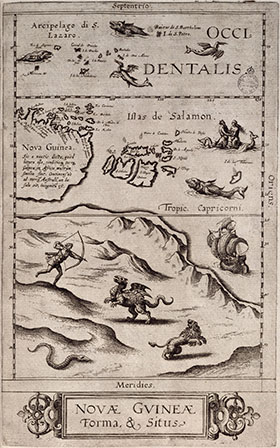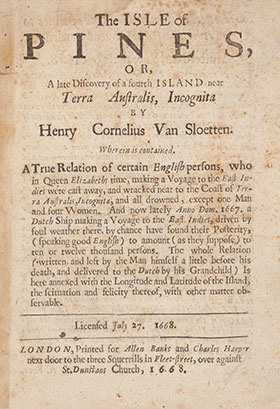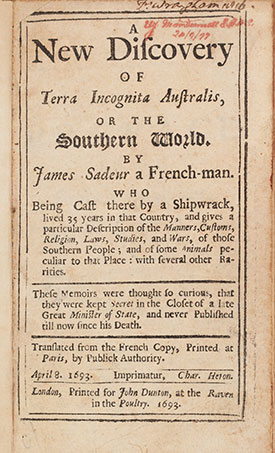Imaginary voyages and utopias
A long held fascination with the undiscovered Southern Continent inspired authors to imagine and write about this mythical land. As a literary and philosophical genre, imaginary voyages were almost as popular in their day as authentic travel accounts. Many were written with their setting in the uncharted Terra Australis Incognita, and featured utopian landscapes and curious inhabitants.
Fanciful notions of the far South Land were common in the European imagination from the early 17th century and even stimulated further expeditions until the late 18th century when exploration finally proved the true extent of the region.
Italian writer Giovanni Botero (1540-1617) reflected the speculation surrounding inhabitants and curiosities to be found in the uncharted lands to the south. His Le Relationi Universali (1618) was a geographic, ethnic and political reference guide to the known world which included 32 woodcuts depicting ‘Monsters and Customs of the Indies’. Fifteen woodcuts portray imaginary ‘monsters’ likely to inhabit the undiscovered lands to the east and south, while another 17 illustrate the actual natives of India, Africa and Arabia. These were precursors to later ethnographic illustrations inspired by discoveries in the Pacific and New World.
> See a fascinating series of woodcuts of Monsters of the Southern World
Joseph Hall’s Mundus alter et idem (1643) was the earliest imaginary utopia, or dystopia, to be set in Terra Australis Incognita. Hall's fanciful society, however, was far from ideal. Like an upside-down world, his land full of gluttons, bandits and snobs was intended to satirise the status quo of England at the time. A map which accompanied the 1643 edition, by accomplished engraver Pieter van der Keeve, shows a deliberately exaggerated southern continent, as large as all the continents north of the equator combined, i.e. Europe, Asia, Africa, mocking the widely held view of an immense unknown Southern Land.
Another fictional English voyage to the Southern Continent was Henry Neville’s Isle of Pines, or, A late discovery of a fourth island near Terra Australis incognita (1676). This account of an island utopia located in the Indian Ocean ‘near the coast of Terra Australis incognita’ was inspired by the Dutch discoveries in the Pacific and tales of shipwrecks off the coast of Western Australia. A publishing sensation in the 17th century, the racy tale of the Englishman George Pine, shipwrecked and castaway with four women on a remote island became a model for many later fantasies of the paradise of the South Seas. The first English edition was published in 1668, followed by a series of French and Italian editions.
The device of the shipwrecked sailor was again used in Gabriel Foigny’s La Terre Austral connue (1676). His marvellous imaginary voyage to ‘Australia’ follows the protagonist Sadeur who is abducted by giant winged monsters and cast adrift in the Indian Ocean off the coast of Western Australia. The island utopia of ‘fourscore and 16 millions’ inhabitants was populated by hermaphrodites with no need for clothes or marriage. The English translation A New Discovery of Terra Incognita Australis, or the Southern World (1693) had the first appearance of the term ‘Australia’ as the name for the Southern Land and ‘Australians’ as the inhabitants. Foigny’s fanciful story is said to have been a forerunner to Jonathan Swift’s Gulliver’s Travels (1726). The sexual undertones of the story landed Foigny in jail and a censored version of the book was later published in 1692 which became the standard text for a century or more.
... a Southern unknown Land has been talkt of these 200 Years : He [the reader] will only wonder, that since the world is now so well furnished with numbers of such skillful and curious Travellers, how it should have continued so long undiscover'd (Preface, New Discovery of Terra Incognita Australis.., by Gabriel de Foigney, 1693)
The best known of this genre is Travels into several remote nations of the world: in four parts, by Lemuel Gulliver (1726), popularly known as Gulliver's Travels, by Irish writer and clergyman Jonathan Swift. The novel was both a satire on human nature and a parody of the ‘travellers' tales’ genre itself. Set partly in Australia, since Lilliput and Blefuscu sit somewhere between New South Wales and New Zealand, Swift utilised known aspects of Terra Australis from increased exploration of the area.
As the years progressed and knowledge of the South Land increased, imaginary voyages were taken over by more sophisticated travel writing and utopias tended to be set in more realistic frameworks. It was not until James Cook’s second voyage of 1772-1775 that the belief in a mythical Great South Land was finally put to rest.



 A new discovery of Terra Incognita
A new discovery of Terra Incognita![Frontispiece from: Terre Australe connue [German edition], by Gabriel de Foigny. Dresden, 1704](/archive/images/discover/history_nation/voyages/imaginary_voyages/MRB_173-James-Sadeur.jpg) Frontispiece from: Sehr curiöse Reise-
Frontispiece from: Sehr curiöse Reise-
